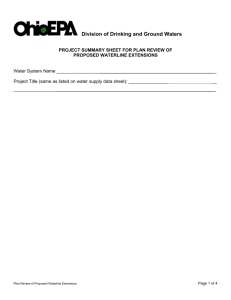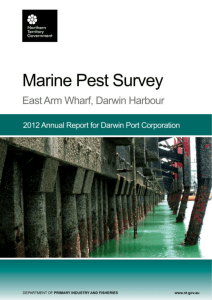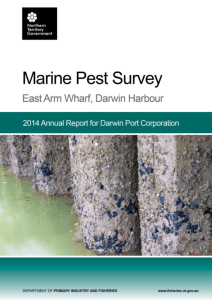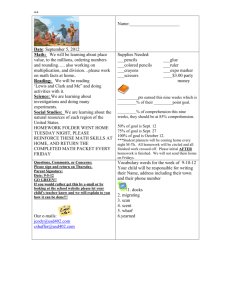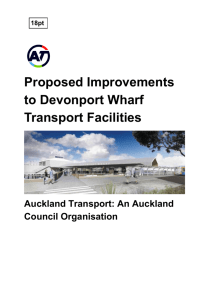2013 - Marine Pest Survey - East Arm Wharf
advertisement
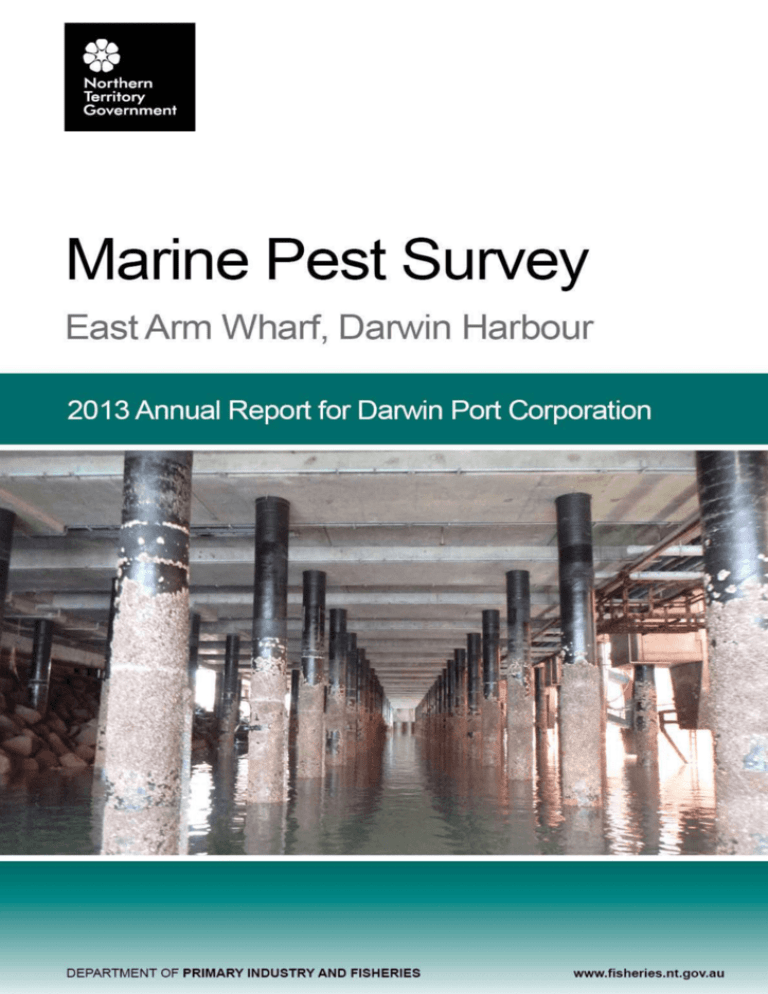
Produced by: Northern Territory Government Department of Primary Industry and Fisheries February 2014 © Northern Territory Government, 2014 M. Skarlatos Simoes conducted this survey and compiled this report with survey assistance from Nathan Crofts and Samantha Tonissoo. Department of Primary Industry and Fisheries GPO Box 3000, Darwin NT 0801, AUSTRALIA Disclaimer While all care has been taken to ensure that information contained in this Report is true and correct at the time of publication, the Northern Territory of Australia gives no warranty or assurance, and makes no representation as to the accuracy of any information or advice contained in this publication, or that it is suitable for your intended use. No serious business or investment decisions should be made in reliance on this information without obtaining independent and/or professional advice in relation to your particular situation. Marine Pest Survey of Eas t Arm W harf, Darwin Harbour 2 TABLE OF CONTENTS LIST OF TABLES ................................................................................................................................................ i LIST OF FIGURES .............................................................................................................................................. i BACKGROUND ................................................................................................................................................... i METHODS ......................................................................................................................................................... 1 Annual Visual Survey ..................................................................................................................................... 1 Settlement Collector Monitoring ..................................................................................................................... 2 RESULTS AND DISCUSSION .......................................................................................................................... 3 Annual Visual Survey ..................................................................................................................................... 3 Settlement Collector Monitoring ..................................................................................................................... 5 APPENDIX ......................................................................................................................................................... 6 LIST OF TABLES Table 1. East Arm Wharf marine pest inspection sites detailing modifications for 2013 inspection. ................. 1 Table 2. Description of biofouling observed from a visual survey of 9 sites along the face of East Arm Wharf on 6 November 2013. ............................................................................................................... 4 Table 3. Settlement collector inspection schedule; January 2013- October 2013. ............................................ 5 LIST OF FIGURES Figure 1. A settlement collector installed at East Arm Wharf (pictured during an extremely low tide). ............. 2 Figure 2. Locations of settlement collectors at East Arm Wharf. ....................................................................... 3 November 2013 i BACKGROUND The Port of Darwin, the closest Australian port to South East Asia, experiences a significant amount of international shipping traffic. As a number of recognised marine pest species are widely distributed throughout South East Asia, the risk of marine pests being introduced to Darwin Harbour is high. Invasive marine pests can cause significant environmental and economic damage. Economic impacts are associated with increased costs for the removal of unwanted fouling from ships and wharf structures, and vessels carrying marine pests being restricted from entering certain ports. Marine pests also present an environmental problem threatening native communities through predation, by overtaking habitats and food sources, or by spreading disease. Once established, it is very difficult to eradicate pests from an aquatic environment. It is therefore important that the initial introduction of marine pests is prevented. Aquatic Biosecurity, within the Fisheries Division of the Department of Primary Industry and Fisheries (DPIF) regularly monitors the marine fouling communities of the Northern Territory (NT) coastline in areas of high international shipping and yachting activity, enabling early detection of marine pest invasions. As part of its marine pest monitoring program, Aquatic Biosecurity has undertaken annual surveys of the fouling organisms growing on East Arm Wharf since 2001. This report presents the findings from a visual survey of East Arm Wharf conducted on 6 November 2013. In addition to the annual survey, monthly monitoring for targeted marine pests was established in November 2007. This monitoring was initiated in response to the detection of a marine pest, the Asian green mussel, on the hull of a rig tender whilst the vessel was alongside the wharf. The use of settlement collectors (deployed with assistance from Darwin Port Corporation staff) allows for monthly assessments of biofouling communities at chosen sites along the wharf face, with particular attention paid to the detection of marine pest species. METHODS Annual Visual Survey Prior to undertaking the survey, permission was sought from Darwin Port Corporation (DPC) to access the wharf face. DPC was advised of the time and duration of the inspection and facilitated access to the wharf front. A visual survey of the wharf face was undertaken on 6 November 2013 between 11:50 am and 12:50 pm on a low tide of 1.25 m. Ten sites along the East Arm Wharf face have been identified for annual inspection (Table 1). Each site is inspected at 3 positions; <0 m, 0-1 m and >1 m above the waterline. The waterline is the actual level of water at time of visual inspection. Due to the presence of a number of commercial vessels alongside the wharf, 2 of the inspection sites were repositioned slightly and 1 site was omitted. At each site, the fouling community was examined for the presence of known marine pest species, photographs were taken, and the general fouling assemblage was recorded. Table 1. East Arm Wharf marine pest inspection sites detailing modifications for 2013 inspection. Site Site location 1 Middle of south eastern face of the multipurpose wharf 2 10 m north west along south western face of the wharf 3 150 m north west along south western face of the wharf 4 250 m north west along south western face of the wharf 5 350 m north west along south western face of the wharf 6 450 m north west along south western face of the wharf 7 550 m north west along south western face of the wharf 8 650 m north west along south western face of the wharf Inspected at 590 m 9 750 m north west along south western face of the wharf Inaccessible 10 Wharf pylons between 750 m and 780 m November 2013 Site details specific to 2013 Inspected at 180 m 1 Settlement Collector Monitoring Settlement collectors used for the monthly inspection of fouling communities were deployed along East Arm Wharf in November 2007. Each collector is connected to the wharf face by a steel cable attached to, and running the length of, the ladders at the wharf face. The collector is made from PVC pipe to which artificial settlement surfaces (settlement plates and rope mops) are attached. The collector is attached to a floating buoy, and the steel cable runs through the centre of the pipe, allowing the collector to move vertically with the tide (Figure 1). The settlement collectors are installed in such a manner as to allow maximum travel with the tidal movement, and minimum exposure of settlement surfaces during extreme low tides. The 2 different types of artificial surface allow for the targeting of a more diverse assemblage of biofouling species. The 2 settlement collectors are positioned approximately half way along the wharf (at the 200-210 m mark) and at the north-western end of the wharf face (at the 780-790 m mark) as depicted in Figure 2 by locations 1 and 2 respectively. Figure 1. A settlement collector installed at East Arm Wharf (pictured during an extremely low tide). Monthly inspections of the collectors involves noting whether or not any marine pests were present on the settlement surfaces, recording a brief description of fouling organisms growing on the plates and within the rope mop, and photographing the plates (front and back) and rope mops using a digital camera. Every 4 months the settlement surfaces are removed for closer examination in the laboratory, which involves an inspection for known marine pests and analysis of the biofouling community. Settlement surfaces are replaced with clean surfaces, which allow for the settlement of more opportunistic biofouling species. Marine Pest Survey of Eas t Arm W harf, Darwin Harbour 2 Figure 2. Locations of settlement collectors at East Arm Wharf. RESULTS AND DISCUSSION Annual Visual Survey The marine fouling organisms observed along the East Arm Wharf face were generally consistent with observations made during previous surveys and included taxonomic groups such as barnacles, bivalves, sponges, hydroids, bryozoans, ascidians, serpullids as well as chitons (Table 2). Barnacles, oysters and sponge were the most abundant organisms at and below the waterline and higher up in the intertidal regions of the wharf face (Appendix A). At and below the waterline in areas subject to less tidal exposure, different biofouling groups such as ascidians (solitary and colonial), bryozoans (branching), sponges and hydroids were also prevalent (Appendix A). No attempt was made to identify every individual species within the fouling community. Only when unusual or suspicious species were observed, were samples collected for identification. In general, the species observed at East Arm Wharf are consistent with those observed throughout Darwin Harbour, and no known marine pest species were detected. November 2013 3 Table 2. Description of biofouling observed from a visual survey of 9 sites along the face of East Arm Wharf on 6 November 2013. Site Site Location Time Comments 1 Middle south eastern face of wharf 12:46 pm Barnacle and oyster species were dominant below, at and above the waterline. A variety of sponge species were also present (pink and white above the waterline, pink, white, orange, green, red, black, brown, white, and purple at the waterline and orange below the waterline). Branching bryozoans were present at and below the waterline. Solitary ascidians were found at and above the waterline. 2 10 m 12:39 pm Oysters and barnacles dominant below, at and above the waterline. An abundance of sponge species were also present (black, red, orange and purple above the waterline as well as white, pink, green and purple at the waterline and green, orange and purple below the waterline). Branching bryozoans were present at and above the waterline. Chitons as well as solitary ascidians were present >1 m above the waterline. 3 180 m 12:32 pm Sponge (all colours previously observed), barnacles and oysters were the dominant taxa below, at and above the waterline. Branching bryozoans and colonial ascidians were found at and below the waterline. 4 250 m 12:28 pm Sponge (black and orange), barnacles and oysters were the dominant taxa below, at and above the waterline. Branching bryozoans were present below and 0-1 m above the waterline. Colonial ascidians were found 0-1 m above the waterline and more sponge species (purple and green) were found >1 m above the waterline. 5 350 m 12:20 pm Barnacles, oysters and sponge (orange, black and green) were the dominant taxa below, at and above the waterline. Branching bryozoans were found below and 0-1 m above the waterline. The sponge species 0-1m above the waterline were more diverse (purple, red, white, green and brown). Colonial ascidians were also observed at this position. 6 450 m 12:15 pm Sponge (black, red and orange), barnacles and oysters were dominant below, at and above the waterline. Below the waterline there was a more diverse array of sponge species including white and green and 0-1m above the waterline there were also white, brown, green and purple species. Branching bryozoans were present 0-1 m above the waterline as well as solitary ascidians. Chitons were present >1 m above the waterline. 7 550 m 12:07 pm Barnacles, oysters and sponge (black, purple, red, green) dominant below and 0-1 m above the waterline. Seagrass, branching bryozoans and sponge (pink, orange and brown) also present 0-1 m above the waterline. Sponge (brown and red) and chitons present >1 m above the waterline. 8 590 m 12:02 pm Oysters and barnacles were the dominant taxa below and 0-1 m above the waterline. Amphipod tubes were present below and 0-1 m above the waterline. Sponge species were present below the waterline (green and orange) as well as 0-1 m above the waterline (orange, red, purple, green, brown and black). 9 750 m 11:58 am No access to this site. 10 Pylons under wharf between 750 m and 780 m 11:50 am Barnacles, oysters and sponge species (orange) were dominant below, at and above the waterline. Colonial ascidians as well as sponge (white and green) were also present 0-1 m above the waterline. Marine Pest Survey of Eas t Arm W harf, Darwin Harbour 4 Settlement Collector Monitoring Unfortunately the inspection of the settlement collectors at East Arm Wharf only occurred on one occasion during the period of January- October 2013 due to the complete removal of the settlement collector and the cable support at the 200-210 m mark and damage, removal or inaccessibility due to vessel traffic at the 780790 m mark (Table 3). Biofouling on the settlement plates (for the month of March) comprised of oysters, barnacles, amphipod tubes and encrusting bryozoans. No recognised marine pest species have been detected on the settlement collectors since commencement of monitoring in November 2007. Table 3. Settlement collector inspection schedule; January 2013- October 2013. Date of inspection Comments 31st January 2013 Collector 1- missing. Collector 2- missing settlement surfaces (2 plates and 1 rope mop) replaced. 22nd February 2013 Collector 1- missing. Collector 2- inaccessible due to vessel traffic along wharf face. 25th March 2013 Collector 1- missing. Collector 2- settlement surfaces inspected and photographed. Missing rope mop replaced. 29th April 2013 Collector 1- missing. Collector 2- inaccessible due to vessel traffic along wharf face. 30th May 2013 Collector 1- missing. Collector 2- inaccessible due to vessel traffic along wharf face. 27th June 2013 Collector 1- missing. Collector 2- missing. 19th July 2013 Collector 1- missing. Collector 2- missing. 30th August 2013 Collector 1- missing. Collector 2- missing. 27th September 2013 Collector 1- missing. Collector 2- missing. 24th October 2013 Collector 1- missing. Collector 2- reinstalled. Accessible from land. November 2013 5 APPENDIX A Representative photographs of biofouling communities on the wharf face at East Arm Wharf, Darwin Harbour on 6 November 2013. Site 1: 0-1 m above waterline Site 2: 0-1 m above waterline Site 3: 0-1 m above waterline Marine Pest Survey of Eas t Arm W harf, Darwin Harbour Site 1: >1 m above waterline Site 2: >1 m above waterline Site 3: >1 m above waterline 6 Site 4: 0-1 m above waterline Site 4: >1 m above waterline Site 5: 0-1 m above waterline Site 5: >1 m above waterline Site 6: 0-1 m above waterline Site 6: >1 m above waterline November 2013 7 Site 7: 0-1 m above waterline Site 7: >1 m above waterline Site 8: 0-1 m above waterline Site 8: >1 m above waterline Site 10: 0-1 m above waterline Marine Pest Survey of Eas t Arm W harf, Darwin Harbour Site 10: >1 m above waterline 8
